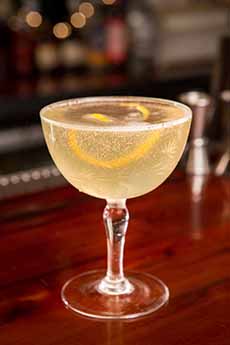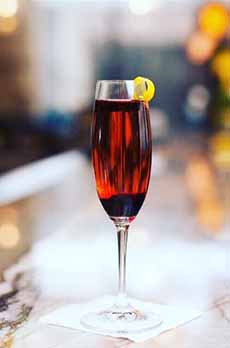French Cocktail Recipes To Celebrate Bastille Day
|
It’s July 14th, the day to toast to Bastille Day (“le quatorze juillet” in French). The holiday is officially called the Fête Nationale (“National Celebration”). Here’s the history of Bastille Day, which commemorates the storming of the Bastille prison in Paris on July 14, 1789. It was a rallying point in the French Revolution. How to celebrate? If you’re near a French restaurant, head there. If not, here are the 25 top French foods you can cook at home. No inclination to cook? Make a sandwich of a crispy baguette, fresh chèvre (goat cheese), sliced tomatoes, and fresh basil leaves, with a grind of fresh pepper and a glass of the French wine of your choice. (This is one of our favorite lunches year-round.) Need some French wine pairings with fresh goat cheese?
A glass of French bubbly is always popular. Add Angostura bitters, sugar, and a maraschino cherry garnish (updated to a lemon or orange twist) and you have a Champagne Cocktail (recipe in ‡footnote). But there are more with which to celebrate. Top French cocktails include the Sidecar, among others. Then, there’s the 1789, the date of the storming of the Bastille (the recipe is below). Some recipes from The Nibble archives: This drink uses a popular French apéritif wine†, Bonal Quina. You can substitute a sweet red vermouth like Punt E Mes. Another ingredient is Lillet Blanc, a French aromatized wine†. If you don’t have any (but we highly recommend it, to drink on its own), a less-sweet substitute is white vermouth. Another substitute is St. Germain elderflower liqueur (another favorite of ours), though it’s sweeter than Lillet. The 1789 is traditionally served in a Martini glass. You can substitute a small wine glass or a Champagne flute. 1. CHILL a Martini glass (or substitute). 2. COMBINE the Bonal Quina, Lillet Blanc, and whiskey In a mixing glass. Add the ice and stir to chill. 3. STRAIN into the chilled Martini glass and garnish with the orange peel. |
|
|
|
________________ *The main grape varieties used in Provençal rosés are Cabernet Sauvignon, Cinsaut, Grenache, Mourvèdre, Syrah, Tibouren, and, occasionally, Carignan. †The difference between fortified wine and aromatized wine: Fortified wines have added alcohol, in the form of flavorless grape brandy. The result is a sweeter, richer version of regular wine. Examples include Madiera, Marsala, Port, and Sherry. Aromatized wines are wines that are flavored with fruit, spices, and florals (angelica, chamomile, chinotto, cinchona, gentian root, mistelle, nutmeg, quinine, and saffron, for example) in addition to the added flavorless grape brandy. Americano (from Italy), Barolo Chinato (Italian), Byrrh (French), Lillet (French), Quinquina (Spanish), and vermouth (originally Italian) are examples. ‡Champagne cocktail ingredients: 1 sugar cube, Angostura bitters, Champagne or other sparkling wine (chilled), lemon or orange twist, for garnish. Place the sugar cube on a bar spoon and douse with bitters. Drop the cube into a chilled Champagne flute. Fill the glass with Champagne or other sparkling wine. Garnish with a lemon or orange twist. Some recipes add brandy, but this is the original. CHECK OUT WHAT’S HAPPENING ON OUR HOME PAGE, THENIBBLE.COM.
|
||





